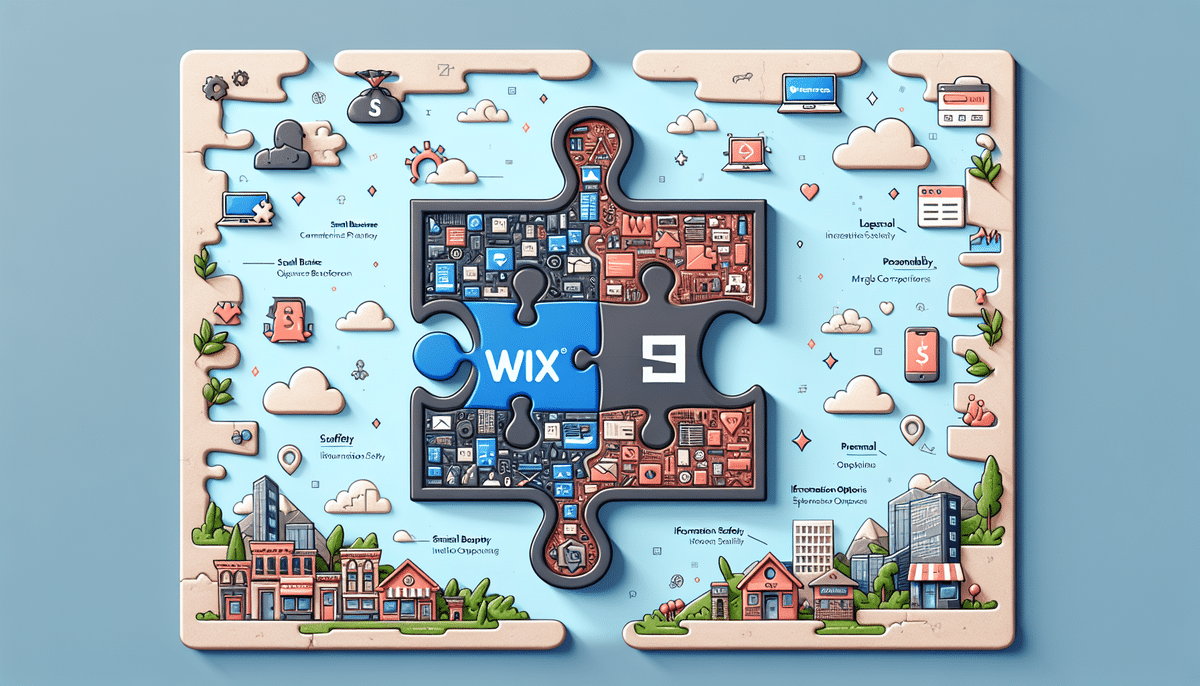Square Online vs Shopify: Comprehensive SEO-Optimized Comparison
In today's digital era, transitioning from physical storefronts to online platforms is essential for business growth. Choosing the right ecommerce platform can significantly impact your success. Two of the most popular options available are Square Online and Shopify. This article delves into their features, pricing, ease of use, customization, payment gateways, integrations, SEO capabilities, customer support, and more. By the end, you'll have a clear understanding to make an informed decision for your ecommerce business.
Overview of Square Online and Shopify
Square Online, launched by Square in 2019, has rapidly gained traction in the ecommerce space, leveraging Square's robust payment processing system. Shopify, established in 2006, is renowned globally for its comprehensive ecommerce solutions and user-friendly interface. While both platforms cater to online businesses, they exhibit distinct differences in terms of features and target audiences.
Evolution and Market Presence
Since its inception, Shopify has expanded its offerings to include a vast array of tools and integrations, making it a preferred choice for businesses of all sizes. Square Online, although newer, benefits from Square's established reputation in payment processing and aims to provide seamless integration for businesses already using Square's ecosystem.
Target Audience
Shopify is ideal for medium to large-scale businesses seeking extensive customization and scalability. Square Online, on the other hand, is perfect for small to medium-sized businesses, especially those already utilizing Square's point-of-sale systems.
Key Features Comparison
Both Square Online and Shopify offer a plethora of features essential for running an online store. However, the depth and flexibility of these features vary between the two platforms.
Store Setup and Design
- Shopify: Offers over 70 professional themes, a drag-and-drop editor, and access to HTML/CSS for advanced customization.
- Square Online: Provides a selection of customizable templates with a focus on simplicity and ease of use.
Product Management
Shopify allows unlimited products across all plans, while Square Online includes up to 100 products on its free plan, offering scalability as your business grows.
Marketing and SEO Tools
Shopify excels with built-in SEO features, integration with Google Analytics, and a range of marketing apps. Square Online offers basic SEO tools and integrates with essential marketing platforms.
Pricing Structures: Square Online vs Shopify
Cost is a pivotal factor when selecting an ecommerce platform. Here's a breakdown of the pricing models for both Square Online and Shopify.
Square Online Pricing
- Free Plan: Includes basic features with Square branding.
- Paid Plans: Start at $12/month for the Professional plan, removing Square branding and adding features like custom domain names and advanced shipping options.
- Transactions Fees: 2.9% + 30¢ per transaction.
Shopify Pricing
- Basic Shopify: $29/month, offering essential ecommerce features.
- Shopify: $79/month, includes additional functionalities like gift cards and professional reports.
- Advanced Shopify: $299/month, provides advanced reporting and third-party calculated shipping rates.
- Transaction Fees: 2.4% + 30¢ for the Basic plan, decreasing with higher-tier plans.
Cost Comparison
While Square Online's initial pricing is more accessible, especially with its free plan, Shopify offers more robust features and scalability at higher price points, making it suitable for growing businesses.
Ease of Use: Getting Started with Square Online and Shopify
User experience is crucial, especially for beginners venturing into ecommerce. Both platforms prioritize ease of use but differ in their approach.
Setup Process
- Shopify: Offers a straightforward setup with guided tutorials and a user-friendly interface.
- Square Online: Provides a simple setup, particularly beneficial for those already familiar with Square's ecosystem.
Dashboard and Navigation
Shopify's dashboard is highly intuitive, offering easy access to all features and tools. Square Online's dashboard is streamlined, focusing on essential functions without overwhelming the user.
Learning Resources
Shopify boasts an extensive library of tutorials, webinars, and a vibrant community forum. Square Online provides essential guides and responsive customer support to assist users.
Customization and Design Flexibility
Your online store's appearance plays a significant role in attracting and retaining customers. Both platforms offer customization options to reflect your brand identity.
Theme Selection
- Shopify: Extensive theme library with both free and premium options, allowing for high levels of customization.
- Square Online: Selects themes tailored for different industries, focusing on simplicity and functionality.
Advanced Customization
Shopify provides access to HTML/CSS and a robust app ecosystem for advanced customizations. Square Online limits customization to predefined templates, which may suffice for businesses seeking simplicity.
Payment Gateways and Processing
Seamless payment processing is vital for customer satisfaction and business operations. Here's how Square Online and Shopify handle payments.
Supported Payment Methods
Both platforms support major payment gateways like PayPal and Stripe, along with credit and debit card payments.
Square Online Advantages
Square Online integrates seamlessly with Square's payment processing, offering a unified system for businesses already using Square's point-of-sale solutions.
Shopify's Payment Flexibility
Shopify supports a broader range of payment gateways, including Shopify Payments, which offers lower transaction fees when used within Shopify's ecosystem.
Integrations and Third-Party Apps
Enhancing your store's functionality through integrations can streamline operations and improve customer experience.
Shopify's App Store
- Over 6,000 apps available, covering areas like marketing, inventory management, shipping, and customer service.
- Examples include apps like Klaviyo for email marketing and ShipStation for shipping solutions.
Square Online Integrations
- Integrates well with Square's suite of products, including inventory management and payroll systems.
- Supports essential third-party integrations like Google Analytics and social media platforms.
Comparison
Shopify's extensive app ecosystem provides greater flexibility and functionality, making it suitable for businesses looking to scale and customize extensively. Square Online offers essential integrations, ideal for businesses seeking simplicity and ease of use.
SEO and Marketing Capabilities
Effective SEO strategies can drive organic traffic and boost sales. Both platforms offer tools to enhance your store's visibility.
Shopify's SEO Features
- Customizable title tags, meta descriptions, and URLs.
- Automatic sitemap generation and easy integration with Google Analytics.
- Support for blogs and content marketing to improve SEO.
Square Online's SEO Tools
- Basic SEO settings, including meta tags and customizable URLs.
- Integration with Google Analytics for tracking and analysis.
- Focus on local SEO for businesses targeting regional markets.
Marketing Tools
Shopify offers a wider range of marketing apps and integrations, such as email marketing tools and social media advertising platforms. Square Online provides essential marketing tools, suitable for small to medium-sized businesses.
Customer Support and Resources
Reliable customer support ensures that you can resolve issues promptly and keep your store running smoothly.
Shopify Support
- 24/7 support via phone, email, and live chat.
- Extensive knowledge base, tutorials, and community forums.
- Access to Shopify Experts for personalized assistance.
Square Online Support
- Support available via email and phone during business hours.
- Comprehensive help center with guides and FAQs.
- Community forums for user discussions and support.
Comparison
Shopify's round-the-clock support and extensive resources provide a more robust support system compared to Square Online, which offers essential support during limited hours.
Pros and Cons: Square Online vs Shopify
Understanding the strengths and weaknesses of each platform can help determine which aligns best with your business needs.
Square Online Pros
- Cost-effective with a free plan available.
- Seamless integration with Square's payment processing and point-of-sale systems.
- Simple and user-friendly setup for beginners.
Square Online Cons
- Limited customization options compared to Shopify.
- Fewer integrations and third-party apps.
- Basic SEO and marketing tools.
Shopify Pros
- Highly customizable with extensive theme and app options.
- Robust SEO and marketing tools.
- Scalable solutions suitable for businesses of all sizes.
Shopify Cons
- Higher cost, especially for advanced features.
- Additional transaction fees if not using Shopify Payments.
- Steeper learning curve for beginners.
Case Studies: Successful Businesses on Square Online and Shopify
Examining real-world examples can provide insights into how different businesses leverage these platforms.
Shopify Success Stories
- Allbirds: A sustainable footwear brand that has scaled rapidly using Shopify's robust ecommerce solutions.
- Gymshark: A fitness apparel company that leverages Shopify's customization and marketing tools to engage a global audience.
Square Online Success Stories
- Local Bakeries: Small bakeries utilize Square Online for seamless integration with Square's payment systems and easy online ordering.
- Artisan Shops: Craft businesses benefit from Square Online's simplicity and affordability to showcase and sell their products.
Migration Tips: Switching Between Square Online and Shopify
Migrating your online store from one platform to another requires careful planning to ensure data integrity and minimal downtime.
From Square Online to Shopify
- Evaluate Your Needs: Determine if Shopify’s advanced features align with your business goals.
- Export Your Data: Use Square Online’s export tools to download product, customer, and order data.
- Set Up Your Shopify Store: Choose a theme, configure settings, and import your data using Shopify’s import tools.
- Test Thoroughly: Ensure all data has migrated correctly and test the checkout process.
- Launch: Point your domain to Shopify and go live.
From Shopify to Square Online
- Assess Platform Features: Ensure Square Online meets your business requirements.
- Export Data: Use Shopify’s export feature to download necessary data.
- Import to Square Online: Utilize Square Online’s import tools to upload your products, customers, and orders.
- Customize Your Store: Adjust themes and settings to match your brand.
- Finalize and Launch: Test your store and make it live.
General Migration Tips
- Backup all data before initiating the migration.
- Utilize available support from both platforms to assist with the transition.
- Plan the migration during low-traffic periods to minimize disruptions.
Conclusion: Choosing the Right Platform for Your Ecommerce Business
Both Square Online and Shopify offer robust ecommerce solutions tailored to different business needs. Shopify stands out with its extensive customization, advanced features, and scalability, making it ideal for businesses aiming for growth and extensive online presence. Square Online excels in simplicity, affordability, and seamless integration with Square’s payment systems, perfect for small to medium-sized businesses and those already using Square's ecosystem.
Ultimately, the choice between Square Online and Shopify depends on your specific business requirements, budget, and long-term goals. Carefully evaluate each platform's features, pricing, and support to make an informed decision that best suits your ecommerce journey.






















